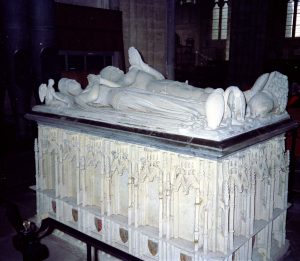 Medieval tombs are an important feature of Exeter Cathedral that capture the attention of modern visitors. The same was true for my fictional heroine, Lady Apollonia, when she visited the cathedral in 1380 in Plague of a Green Man. Some of these tombs include a sculpted effigy or model of the deceased person or persons buried within. Some of them existed in 1380 when the Lady took her tour, but others have been added since 1380.
Medieval tombs are an important feature of Exeter Cathedral that capture the attention of modern visitors. The same was true for my fictional heroine, Lady Apollonia, when she visited the cathedral in 1380 in Plague of a Green Man. Some of these tombs include a sculpted effigy or model of the deceased person or persons buried within. Some of them existed in 1380 when the Lady took her tour, but others have been added since 1380.
The oldest tomb effigy is in the Lady Chapel and represents either Bishop Bartholomew Iscanus who died in 1184 or Bishop Leofric who supervised the move of the see from Crediton to Exeter in 1050 and died in 1072. The relief carving of this early bishop, done near the end of the 12th century, is much more shallow than is found in later fully rounded, sculpted bodies of the 12th and 13th centuries. This most ancient effigy clearly shows the bishop holding his crozier and displaying the ring of his office. The emphasis is that the deceased was a bishop but there was probably no attempt to portray a realistic representation of the person.
In Plague of a Green Man, Lady Apollonia notices the effigies of two knights in the south quire aisle. It was one of these effigies that inspired me to develop the title for my first novel, Effigy of the Cloven Hoof. The Lady’s tour included the quire aisles and the Lady Chapel where most of the tomb effigies were located at that time.
Two of the effigies in the north quire aisle inspired some ideas in writing my third novel, Memento Mori. One is the effigy of a transi tomb which shows the effigy body in decay or transition, a concept which became popular after the Black Death struck England five times in the 14th century. The other is the monument of Sir Robert Stapledon who died in 1320. Stapledon’s tomb not only presents the effigy of him as a knight with his legs crossed but also features two small accompanying figures: one is his squire and the other a page leading the knight’s horse. I used this monument as my inspiration for the tomb which Lady Apollonia commissioned after the death of her fourth son, Sir Alban.
The tomb of Bishop Lacey in the north quire aisle tells an interesting story. Masons were doing repairs to the stone screen above this tomb about a year and a half after a German air raid on Exeter. They discovered small fragments of unpainted wax images varying in colour from dirty pale yellow to a deep terra-cotta. Many were images of body parts, hands, feet, legs, all the way up to an 8-inch figure of a woman. It is thought that these wax images may have been hung from the railing above Lacey’s tomb as votive offerings by those seeking his intervention for healing in various parts of their body which they illustrated for him with the wax images.
Effigies in the south transept of Hugh Courtenay, the Earl of Devon, and his Countess, Margaret de Bohun, shown in the above picture, are helpful because they may portray the kind of armour and clothing worn in the 14th century by a nobleman and his wife.
For more on tomb effigies, click on
https://en.wikipedia.org/wiki/English_church_monuments .
Tags: Chaucer's England, historical fiction, medieval mysteries